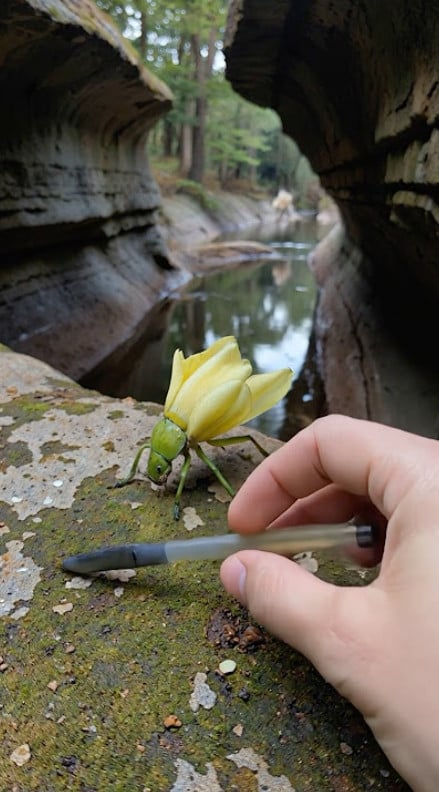Over the past few months, a video has spread across TikTok, Instagram, and YouTube showing what appears to be a beetle that transforms into a delicate yellow water lily when touched. The insect is referred to as Nymphaeomorphus Vigilis, supposedly discovered in Whispering Gorge, a fictional-sounding location in the Pacific Northwest.
The clip sparked fascination and disbelief. Viewers were stunned by what looked like a new hybrid of plant and animal. Comments hailed it as one of the greatest biological discoveries of the century, while skeptics immediately suspected CGI or AI trickery.
But what is the truth? Could a beetle that blossoms into a flower actually exist, or is this just another example of a viral AI hoax? In this article, we investigate the origins of the claim, analyze the scientific red flags, and reveal how digital art tools are driving a wave of nature hoaxes online.

What the Viral Video Claims
The viral footage describes Nymphaeomorphus Vigilis as a shy beetle living in damp, hidden corners of Whispering Gorge. According to the captions and “field notes” circulating with the video:
- When approached, the beetle transforms into a yellow water lily as a defensive mechanism.
- The transformation is instantaneous, with petals unfolding from its back.
- It thrives in shaded wetland environments in the Pacific Northwest.
- The scientific name suggests a taxonomic classification, implying legitimacy.
At first glance, the idea is captivating. The insect seems to mimic aquatic plants to survive, a concept that resonates with real-world examples of mimicry in the animal kingdom.
Fact-Check: Is Nymphaeomorphus Vigilis Real?
The short answer is no. The beetle that transforms into a yellow water lily is not real. It is a digitally fabricated illusion, created using AI art platforms such as Krea AI, as well as CGI video-editing tools.
No scientific record exists for a species called Nymphaeomorphus Vigilis. There is no evidence of such an insect in entomology databases, no peer-reviewed research papers, and no official discoveries announced by credible scientific organizations.
The Red Flags That Expose the Hoax
Several glaring issues reveal that this viral beetle is fabricated.
1. The Scientific Name is Fake
The name Nymphaeomorphus Vigilis is constructed to sound like legitimate taxonomy but breaks conventions.
- Nymphaeo- comes from Nymphaea, the genus for water lilies.
- Morphus implies “form” or “shape.”
- Vigilis is a Latin word for “watchful.”
Put together, it translates roughly to “watchful water lily form.” While it sounds plausible, no recognized taxonomy database contains this name. Legitimate species are always registered, described in scientific journals, and catalogued.
2. Insects Cannot Sprout Flowers
From a biological perspective, insects and plants belong to completely different kingdoms of life. While mimicry and camouflage exist, physical transformation into a flowering plant is impossible. Evolutionary biology offers no mechanism for an animal to produce plant structures like petals, stamens, or chlorophyll.
3. The Video Reveals Digital Artifacts
Close inspection of the viral clip reveals irregularities:
- Lighting inconsistencies between the beetle and its background.
- Unrealistic unfolding of petals, too symmetrical and glossy.
- Movements that resemble animation rather than natural biology.
4. The “Made with Krea AI” Tag
Some versions of the video contain a watermark reading “Made with Krea AI.” This AI platform generates hyper-realistic images and animations. That tag alone confirms the footage is artificial.
5. The Source Account’s History
The viral clip was circulated by accounts such as olegpars7 and similar creators, many of whom specialize in AI insect-flower hybrids. These accounts have shared multiple hoaxes, including beetles that bloom into roses and mantises disguised as tulips.
Why People Believed the Hoax
Despite the obvious signs of fabrication, millions of viewers were captivated by the video. Why?
1. Scientific-Sounding Names
Invented Latin names create a sense of legitimacy, tricking audiences into believing a species has been formally classified.
2. Exotic Location
“Whispering Gorge” sounds mysterious and remote. Associating a claim with an unknown or magical-sounding location makes it harder for people to fact-check.
3. Desire for Discovery
Humans crave wonder. The possibility of finding new species fuels excitement. Social media thrives on the extraordinary, not the ordinary.
4. Believable Inspiration
Nature already offers stunning examples of mimicry. Orchid mantises resemble flowers. Leaf insects mimic foliage. Jewel beetles glisten like gems. Adding one extra step—a beetle blooming into a flower—feels like a natural extension of reality.
Real-Life Insects That Inspired the Hoax
Although Nymphaeomorphus Vigilis is fake, the hoax borrows inspiration from real-world insects with fascinating adaptations.
- Orchid Mantis (Hymenopus coronatus): This mantis resembles orchid petals, luring pollinators that become prey.
- Leaf Insects (Phylliidae): Masters of camouflage, they look exactly like green leaves, complete with veins and bite marks.
- Jewel Beetles (Buprestidae): Known for metallic, iridescent exoskeletons.
- Flower Beetles (Cetoniinae): Brightly colored scarab beetles often found feeding on blossoms.
These examples show the wonders of evolution, but none cross the boundary into becoming actual flowers.
The Role of AI in Nature Hoaxes
The rise of AI art tools like Krea AI, MidJourney, and Stable Diffusion has enabled creators to produce hyper-realistic animal-plant hybrids. Once shared on social media, these clips spread without context, blurring the line between digital art and real science.
This trend creates challenges for both educators and scientists. While creativity is valuable, misinformation spreads quickly, confusing audiences and overshadowing real ecological discoveries.
Why Whispering Gorge Was Chosen
The supposed discovery site, Whispering Gorge, adds to the mystique. While it sounds like a natural landmark in the Pacific Northwest, there is no documented location by that name in official U.S. geological records. The fabricated name was likely chosen to enhance believability while remaining vague enough to avoid scrutiny.
The Psychology of Viral Hoaxes
The popularity of Nymphaeomorphus Vigilis reveals much about digital culture:
- Curiosity Bias: People are drawn to extraordinary claims because they challenge expectations.
- Shareability: Visual surprises make for perfect viral content.
- Authority Illusion: Latin names and pseudo-scientific notes lend false credibility.
- Community Excitement: Viewers bond over wonder and debate, boosting algorithmic reach.
How to Spot Future Fake Species
To avoid being misled by future hoaxes, keep these tips in mind:
- Check Scientific Databases: Verify species names in trusted taxonomic resources.
- Search for Peer-Reviewed Studies: True discoveries are always documented.
- Look for Digital Artifacts: Unnatural lighting, overly perfect symmetry, or watermarks.
- Analyze the Source: If the clip comes from an AI art account, skepticism is warranted.
- Ask if It’s Too Perfect: Nature is wondrous, but rarely flawless.
Why This Matters
Some may argue that viral hoaxes are harmless fun. However, they have real consequences:
- They spread misinformation, making it harder to distinguish fact from fiction.
- They erode trust in real scientific communication.
- They distract from genuine ecological issues, such as species extinction and habitat loss.
- They reinforce the idea that science must be sensational to be valuable.
Lessons from the Nymphaeomorphus Vigilis Hoax
The beetle-flower illusion teaches several important lessons:
- Digital Art is Powerful: AI tools can create stunning visuals, but they should be clearly labeled as art.
- Critical Thinking is Essential: Audiences must learn to question viral content.
- Nature is Already Amazing: Real insects showcase extraordinary adaptations without digital enhancement.
Final Verdict: Real or Fake?
After analyzing the evidence, the verdict is clear: Nymphaeomorphus Vigilis is fake. The beetle that supposedly blooms into a yellow water lily does not exist. It is an AI-generated hoax designed for entertainment and viral engagement.
The Latin name is fabricated, the location is fictional, and the video itself contains AI watermarks. While entertaining, it is not a scientific discovery.
Conclusion: Appreciating Real Wonders
The viral story of Nymphaeomorphus Vigilis captured attention because it tapped into human fascination with nature’s mysteries. But the real world already offers spectacular wonders: orchid mantises, iridescent beetles, and dragonflies with jewel-toned wings.
By learning to separate fact from fabrication, we can celebrate genuine biodiversity while also enjoying digital art for what it is—imagination, not science.
The next time you see a beetle blooming into a flower on your feed, remember: extraordinary claims require extraordinary evidence. And in this case, the truth is that nature doesn’t need AI embellishment to be extraordinary.
Frequently Asked Questions About the Nymphaeomorphus Vigilis Hoax
1. What is Nymphaeomorphus Vigilis?
Nymphaeomorphus Vigilis is the name given to a viral, AI-generated beetle that supposedly transforms into a yellow water lily when touched. Videos claim it was filmed in Whispering Gorge in the Pacific Northwest. However, no such species exists in real science. It is a fabricated digital illusion created with AI art tools and CGI animation.
2. Is the beetle that turns into a flower real?
No, the beetle is not real. Insects and plants belong to entirely different biological kingdoms, making it scientifically impossible for an insect to sprout flowers. The viral videos are digital creations, not recordings of actual wildlife.
3. Why do people believe in Nymphaeomorphus Vigilis?
Many viewers are convinced because:
- The name sounds like authentic Latin taxonomy.
- The supposed discovery site, Whispering Gorge, sounds exotic and believable.
- Nature already features insects that mimic flowers or leaves, so the idea feels plausible.
- The videos are visually convincing due to advanced AI rendering.
4. Where did the video originate?
The earliest versions of the video appeared on social media accounts known for AI-generated art, including creators who specialize in insect-flower hybrids. Some clips even carry the “Made with Krea AI” watermark, confirming their artificial origin.
5. How do we know it is a hoax?
Several red flags expose the scam:
- No scientific journal or database lists Nymphaeomorphus Vigilis.
- The name itself is fabricated by combining parts of Latin words.
- The video shows unnatural lighting, symmetrical petals, and animation-like movements.
- The creators themselves often tag their content as AI-generated.
6. Is Whispering Gorge a real place?
No, Whispering Gorge does not exist in U.S. geological records or maps. It was likely invented to make the claim sound mysterious while avoiding easy fact-checking.
7. Are there real insects that look like flowers?
Yes, but they do not transform into actual plants. Examples include:
- The orchid mantis, which mimics orchid petals.
- Leaf insects, which resemble leaves down to vein patterns.
- Flower beetles, which feed on blossoms and often have colorful shells.
These adaptations are forms of mimicry, not physical blooming.
8. Why do AI-generated hoaxes like this go viral?
They spread quickly because they are visually striking, short in format, and designed for maximum shareability. People want to believe in hidden natural wonders, and AI-generated hoaxes exploit that curiosity.
9. What are the dangers of believing such hoaxes?
While some consider them harmless fun, they can:
- Spread misinformation about science.
- Undermine trust in real discoveries.
- Distract from urgent conservation issues involving actual endangered species.
- Contribute to the blurring of fact and fiction in digital culture.
10. How can I fact-check similar viral claims in the future?
To avoid being misled, follow these steps:
- Search the species name in reputable scientific databases.
- Look for coverage in credible science news outlets.
- Check if the video shows watermarks from AI platforms.
- Be skeptical of extraordinary claims without peer-reviewed evidence.










